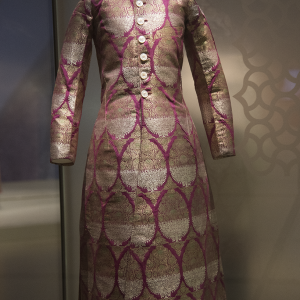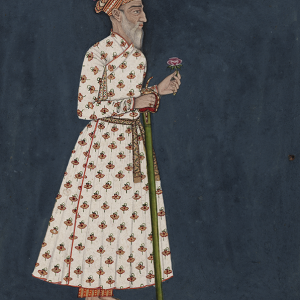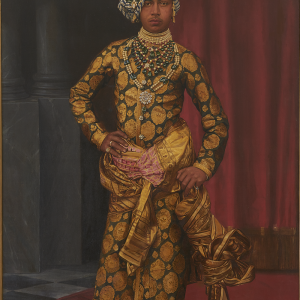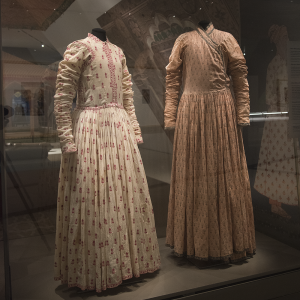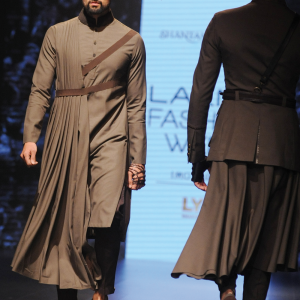A Fashion Dialogue Between East and West
The sherwani is one of the most recognizable forms of male Indian dress. This structured jacket, simply cut and beautifully embellished, is often seen at social functions, weddings, and in film. Western designers have been inspired by this garment, often citing portraits of Rajput rulers enrobed in sherwani and lavishly bejewelled as their inspiration. These factors have made the sherwani, second perhaps only to the sari and the Taj Mahal, the most dominant signifier of Indian identity to a Western audience. Here, we examine the complex history of the sherwani and its related garments to reveal the political and cultural importance of the royal arts featured in Treasures of a Desert Kingdom: The Royal Arts of Jodhpur, India.
From left to right: 1) Ceremonial Coat (Sherwani) Early 20th century Silk, silver, gold, cotton Mehrangarh Museum Trust COS 89, 2) Mughal Emperor Aurangzeb (ruled 1658–1707), wearing a block-printed jama Unknown artist Deccan, India, late 17th century Opaque watercolour on paper Royal Ontario Museum 965.67.2, Shantanu and Nikhil sherwani design at Lakme Fashion Week Winter 2016, 3) Portrait of Maharaja Sardar Singh Artists: Bert Harris (painter), Johnston & Hoffman Studio (photographer) 1896 Oil on canvas based on a photograph Umaid Bhawan Palace UBP 102
Western tailoring, Indian craftsmanship
Fabrication and textile arts
The sherwani is an excellent canvas to display India’s diverse textile arts. Royal patronage of local artisans served a symbolic as well as economic purpose. It also ensured the survival of craftsmanship, while contributing income to the textile trade. Such an understanding was ingrained in the history of the Royal Court, dating back to the Arthashastra treatise of the fourth century BCE that mandated kings to support the arts. Skilled artisans were highly prized citizens, whom kings went to great lengths to settle in their states. Large halls at court were devoted to fabric weavers, dyers, embroiderers, jewellery makers, and block printers. Block printing was, and still is, an important craft, often involving vibrant colours and gold leaf embellishments. Different types of embroidery are also showcased on the sherwani, with zardozi, gota, and danka being common forms of embellishment.
As Indian tastes shifted toward Western influences in the 19th century, fabrications also changed. Lighter fabrics and looser construction gradually gave way to stricter tailoring and heavier, more ornamented fabrics like brocade. A fantastic example is the late-nineteenth-century sherwani displayed in Treasures of a Desert Kingdom.
The sherwani is one of the most recognizable forms of male Indian dress.
“ ”Left to right: 1) Man’s Robe (Angarkha) Western India, probably Gujarat, late 18th century– early 19th century Embroidered white cotton and silk thread Mehrangarh Museum Trust COS 85 2) Shantanu and Nikhil sherwani design at Lakme Fashion Week Winter 2016.
Garments before the sherwani
Before the sherwani, the jama and angarkha were prominent among the ruling class. A favourite of Mughal emperors, the jama—Persian for “garment”—is a high-waisted coat that fits snugly over the chest and has a wide skirt. It is held in place by a tie under the armpit. The flared skirt made it easy to ride a horse and sit on the floor, while the cotton fabric was well suited to the desert heat. The angarkha is similar in cut, with the addition of a closed front panel that fastens at the waist. Treasures of a Desert Kingdom features an example of each of these historical men’s fashions. Painted portraits of rulers and court life show the widespread use of these garments. Together with the sherwani, images of Indian rulers wearing the jama and angarkha constitute the idea of “royal India” in the western imagination.
The sherwani in Western haute couture
Many Western fashion designers have found inspiration in these images, as well as in the garments themselves. Arguably, the most influential designer so inspired was Yves Saint Laurent (1938–2008). This French icon and successor to Christian Dior transformed Western fashion by popularizing pantsuits for women, introducing luxurious ready-to-wear, and connecting high fashion to the street. Saint Laurent possessed a vivid imagination, preferring to “see” countries through images and objects rather than actual visits. He memorably remarked, “I have been to every country in my dreams. I only have to look at a beautiful book about India and I can sketch as if I had been there. This is what the imagination can do.”
As early as 1962, Saint Laurent was looking to India for ideas, and would continue doing so up until his final hautecouture collection in 2002. Saint Laurent liberally borrowed Indian designs, such as the turban, the sari, and Mughal ornamentation, seamlessly integrating these elements into his sophisticated, bohemian aesthetic. He was also heavily inspired by the sherwani, referencing its tension between simple cut and lavish embellishment. His earliest adaptation of the garment is faithful to its Indian origins, yet the French designer took the traditionally masculine sherwani and re-cut it for women, blurring traditional gendered modes of dress. Saint Laurent’s iteration blends the ease of the angarkha, the tailored cut of the sherwani, and the underpinning of the pajama (trousers) into one garment. The French couturier would continue to be influenced by India, often through his house model, the Indian-born Kirat Young. She would bring him postcards, textiles, and jewellery whenever she returned from trips to visit family in New Delhi.
In more recent years, the sherwani continues to influence important European fashion designers. For example, Karl Lagerfeld’s (1933–2019) Pre-Fall 2012 Métiers d’Arts collection for Chanel, titled “Paris–Bombay,” was a riotous romp through the icons of Indian aesthetics and prominently featured many adaptations of the sherwani.
Looking back at these collections now, one can reflect on the distinction between inspiration and cultural appropriation. Accolades and accusations have been similarly lobbed at both designers throughout their careers. In the case of Saint Laurent, he defended his Indian inspirations, citing them as an important catalyst that helped him see Western fashion through a new lens.
Contemporary Indian designers reframe the sherwani
A new crop of contemporary Indian designers are reclaiming their dress heritage. These creatives seek to preserve traditional craftsmanship, while reimaging garments like the sherwani for a new age. Couturier Sabyasachi Mukherjee and the design duo Shantanu & Nikhil take this mandate seriously, albeit with differing approaches. Kolkata-based Mukherjee, known for his collaboration with Christian Louboutin, champions heritage production, showcasing hand dyeing, embroidery, weaving, and block-printing techniques in his designs. His aesthetic is heavily influenced by the Royal Court, incorporating garments like the sherwani. This savvy businessman is an advocate for craftsmanship, employing many artisans to ensure the continuity of their techniques. The designers behind Shantanu & Nikhil echo Mukherjee’s ethos, with different results. The brothers see their work as a “progressive fusion” of ideas, blending Western tropes such as Victoriana and military tailoring with heritage garments like the sherwani. The result is a unique hybrid of both worlds that recalls India’s sartorial heritage while pointing to the future.
The sherwani is a richly layered garment that explores the complex interplay between India and the West. The garment’s many reinventions have charted global history across pre-modern and modern territorial borders, from its use by Rajput rulers to the exoticized fantasies of Yves Saint Laurent and Karl Lagerfeld.Today, the reinvention of the sherwani continues in the hands of contemporary Indian designers. These modern creatives are refashioning India’s heritage to reflect its bright future.


